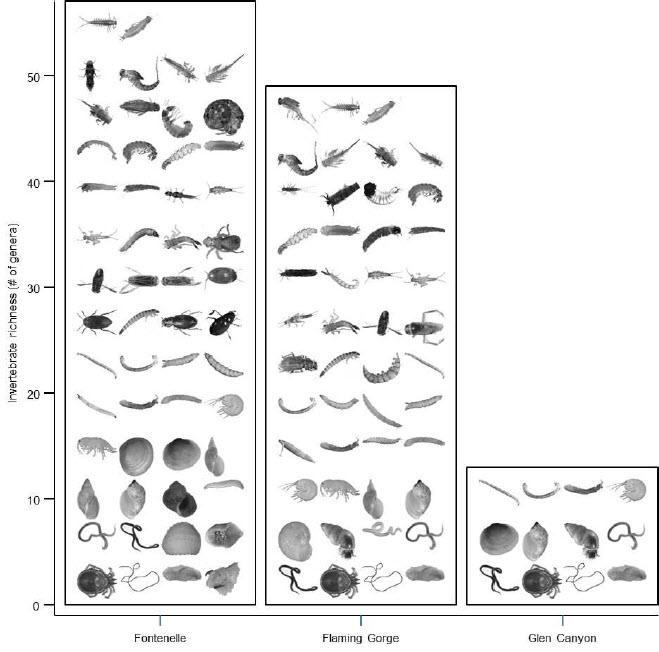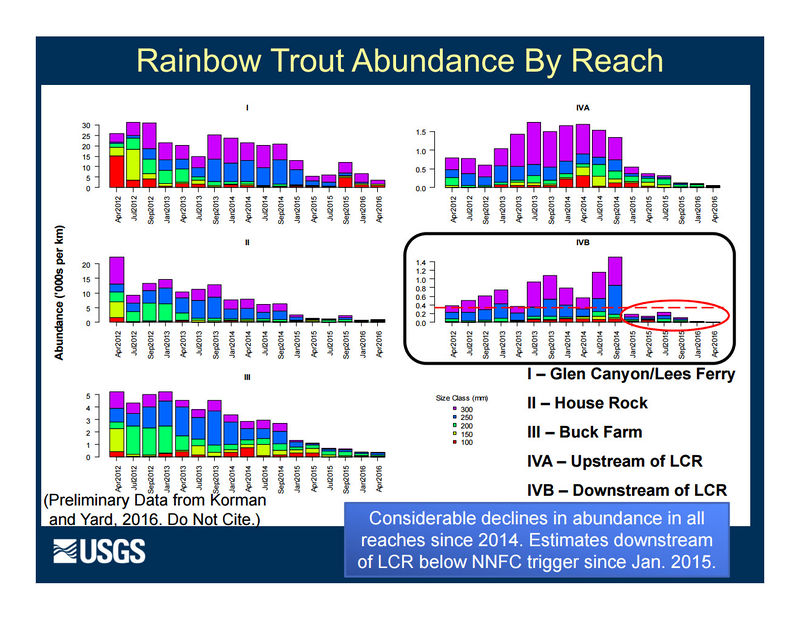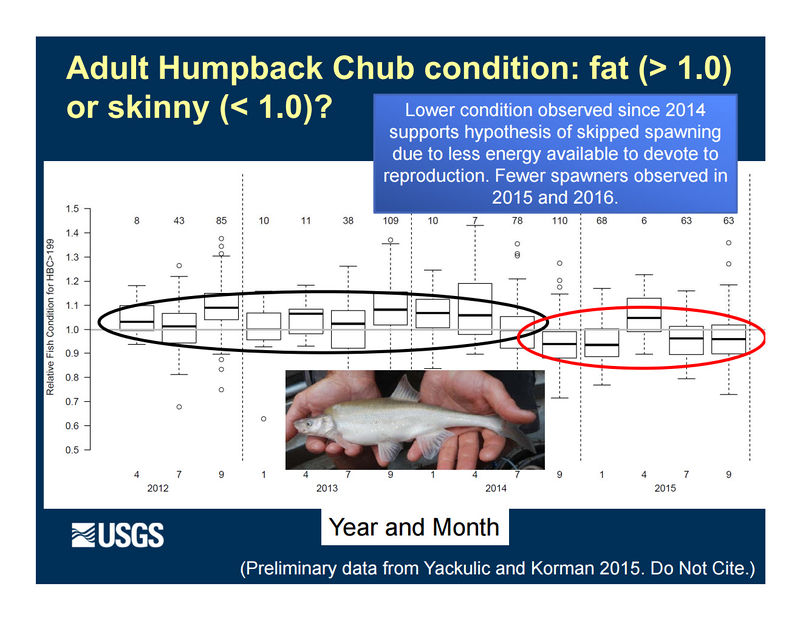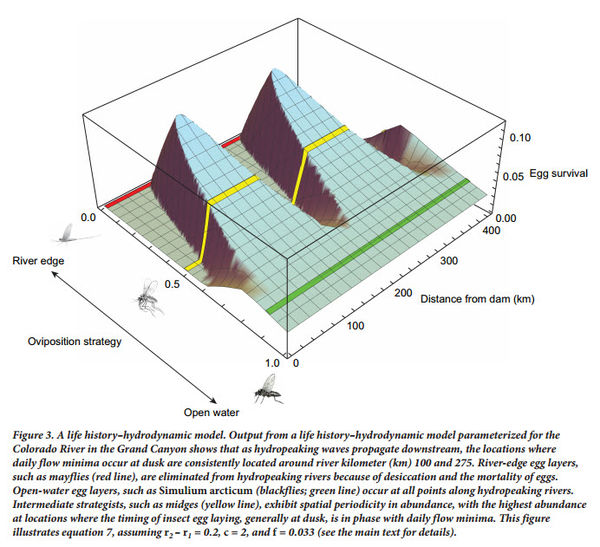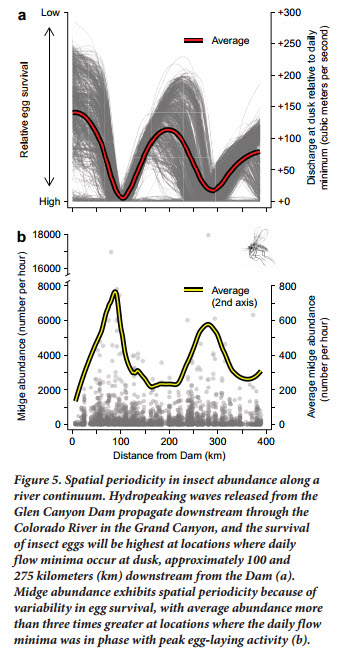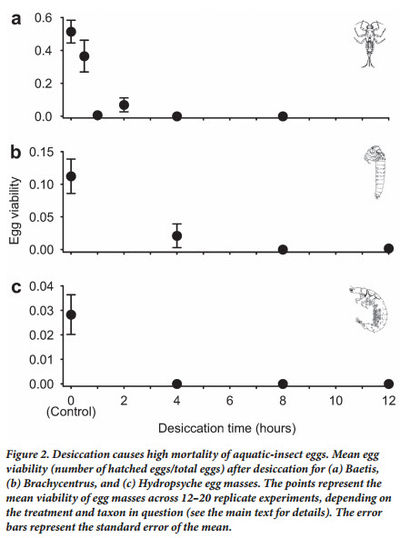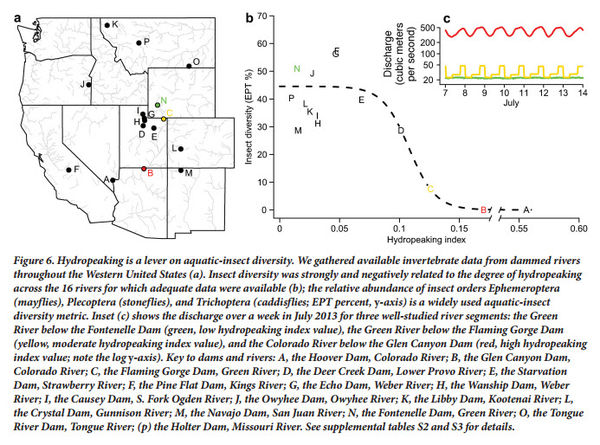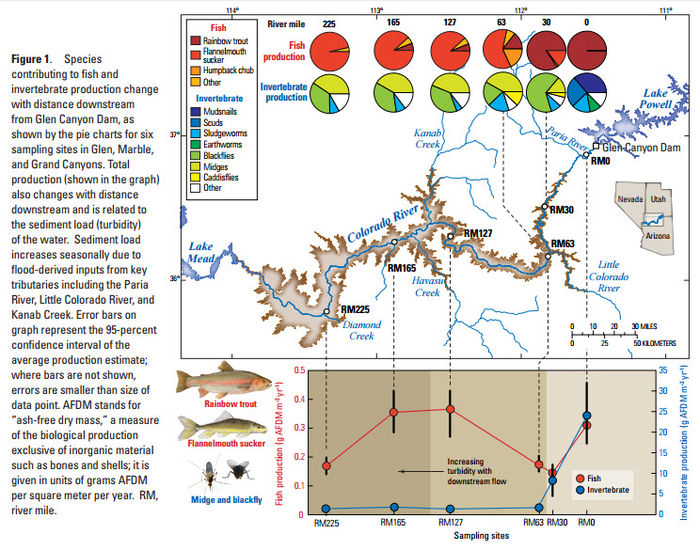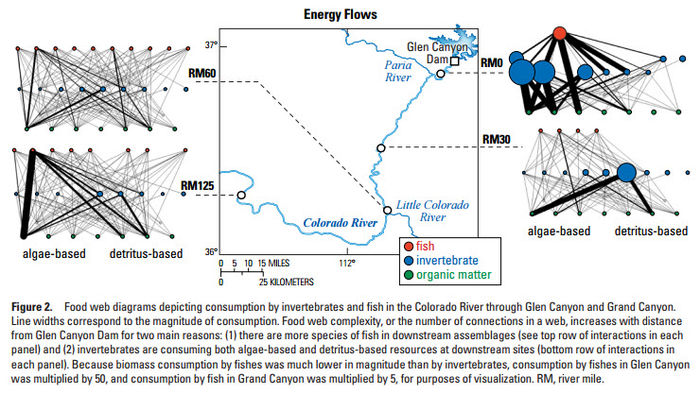Difference between revisions of "FOOD BASE"
Cellsworth (Talk | contribs) |
Cellsworth (Talk | contribs) |
||
| Line 47: | Line 47: | ||
|style="color:#000;"| | |style="color:#000;"| | ||
| − | [ | + | During periods of high fish abundance, food limitation can lead to extreme competition between [http://gcdamp.com/index.php?title=FISHERY '''rainbow trout'''] and [http://gcdamp.com/index.php?title=Humpback_Chub_Page '''humpback chub'''] for limited food resources resulting in large swings in in the trout population and skip spawning in the humpback chub population. These effects can be amplified by [http://gcdamp.com/index.php?title=TEMPERATURE increasing '''water temperature'''] if food production or availability don't correspondingly increase because warmer water increases fish metabolism requiring them to eat more food in order to maintain body condition. |
| + | [[File:NO TroutAbundances2016.jpg|center|800px]] | ||
| + | [[File:HBCcondition2016.jpg|center|800px]] | ||
| + | ---- | ||
| + | |||
| + | [[Media:Kennedy 2016 HydropowerEPT.pdf| '''Kennedy's 2016 Bioscience paper''']] presents a conceptual model describing how hydropower flows could be limiting aquatic insect diversity and production by limiting the reproductive success of insects accustom to laying their eggs along the shoreline. It provides supporting data from an egg desiccation study done below Flaming Gorge Dam, light trap data collected in the Grand Canyon, and a comparison of fluctuation intensity and EPT diversity in several western US hydropower tailwaters. The paper concludes that egg desiccation from fluctuating flows is likely a leading factor in limiting aquatic insect diversity and production in tailwaters below hydropower facilities. The paper also proposes a '''[[The Bugflow Experiment| bugflow experiment]]''' to be tested at Glen Canyon Dam as a possible mitigation for fluctuating flows made for hydropower production. | ||
[[File:EPThydropeakingModel.jpg|600px]] | [[File:EPThydropeakingModel.jpg|600px]] | ||
[[File:MidgeAbundanceFlow.jpg|400px]] | [[File:MidgeAbundanceFlow.jpg|400px]] | ||
| Line 55: | Line 60: | ||
---- | ---- | ||
| − | |||
| + | [http://www.gcmrc.gov/about/foodbase/Cross%20et%20al._EM_2013.pdf '''Recent food web studies (2006-2009)'''] conducted in collaboration with University of Wyoming, Montana State University, Idaho State University, and the Cary Institute for Ecosystem Studies revealed that fish populations in the Colorado River downstream from Glen Canyon Dam appear to be limited by the availability of high-quality invertebrate prey. Midge and blackfly production is low and nonnative rainbow trout in Glen Canyon and native fishes in Grand Canyon consume virtually all of the midge and blackfly biomass that is produced annually. In Glen Canyon, the invertebrate assemblage is dominated by nonnative New Zealand mudsnails, the food web has a simple structure, and transfers of energy from the base of the web (algae) to the top of the web (rainbow trout) are inefficient. The food webs in Grand Canyon are more complex relative to Glen Canyon, because, on average, each species in the web is involved in more interactions and feeding connections. Based on theory and on studies from other ecosystems, the structure and organization of Grand Canyon food webs should make them more stable and less susceptible to large changes following perturbations of the flow regime relative to food webs in Glen Canyon. In support of this hypothesis, Grand Canyon food webs were much less affected by a 2008 controlled flood relative to the food web in Glen Canyon. | ||
[[File:Foodbase fish production1.jpg|center|700px]] | [[File:Foodbase fish production1.jpg|center|700px]] | ||
[[File:Foodbase energy flows1.jpg|center|700px]] | [[File:Foodbase energy flows1.jpg|center|700px]] | ||
| − | |||
| − | |||
| − | |||
| − | |||
|} | |} | ||
Revision as of 14:12, 23 November 2016
|
|
The Aquatic Food Base below Glen Canyon DamThe Colorado River below Glen Canyon Dam has been altered by dam-induced modifications to the river’s flow, temperature, and sediment supply. Nonnative species have also changed the natural system. Nonnative fish are thought to prey on and compete with native fish, including the endangered humpback chub (Gila cypha). These impacts have likely changed both the amount and sources of energy that fuel the aquatic food web and the flows of energy within the food web. Installation of the dam created a relatively clear, cool aquatic environment below the dam that now allows aquatic plants to capture the sun’s energy, and they in turn are now consumed by a few species, including scuds (Gammarus lacustris), midges (Family: Chironomidae), blackflies (Simulium arcticum), and New Zealand mudsnails (Potamopyrgus antipodarum). The first three species can provide food for both native and nonnative fishes, but fish cannot digest the New Zealand mudsnail. Desired Future Condition for the Aquatic Food BaseThe aquatic food base will sustainably support viable populations of desired species at all trophic levels. Assure that an adequate, diverse, productive aquatic foodbase exists for fish and other aquatic and terrestrial species that depend on those food resources. |
| --- |
 |
--- |
|---|
|
|
